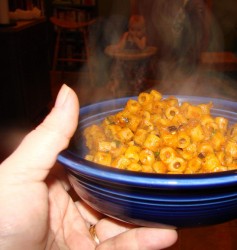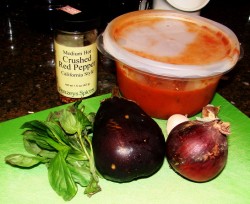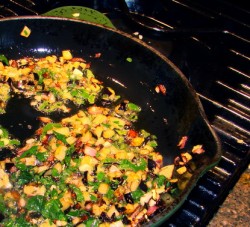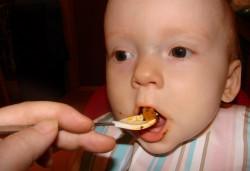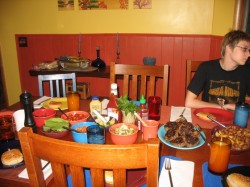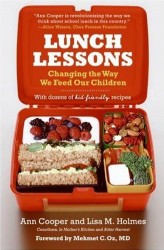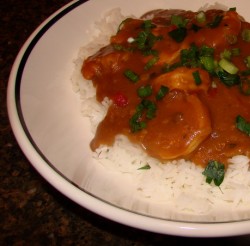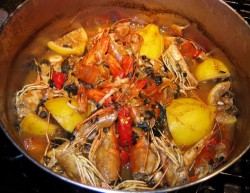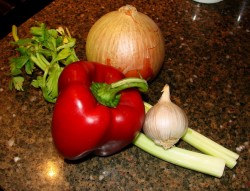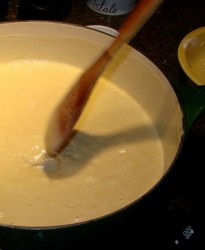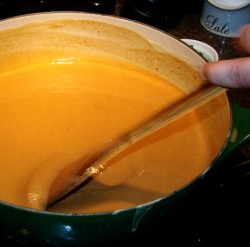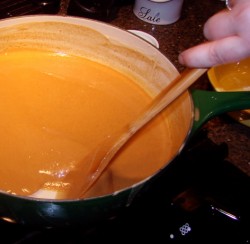Ditalini With Eggplant, Kale and Caramelized Onions: Mamma’s Necessary Invention
When it is lunchtime, and a Mom has a hungry baby on her hands, she has to work fast.
It’s a thing.
But, I am too lazy of a Mom to want to cook something for Kat, and then something for myself and whoever else is around during the lunch hour, so, I just improvise, and cook something we will all enjoy. And since I am blessed with Kat who has an open mouth and mind when it comes to flavors, I can get away with quite a bit of creativity in the kitchen.
Like yesterday, I needed to make a fast lunch for Kat and I while her Dad and Big Sister were out having a driving lesson and bonding session. I was lucky in that I had my very own homemade convenience food sitting in the fridge, thawed out and ready to use: previously frozen homemade marinara sauce. It is like opening a jar of store-bought spaghetti sauce, but it tastes so much better because the ingredients it came from were fresh, and they are in proportions which I like: lots of caramelized onions, lots of garlic, very fresh basil and dry red wine, along with plump, meaty fully-flavored Roma tomatoes. I bought twenty-five pounds of them–organically grown–at the farmer’s market one weekend this September for eighteen dollars, and turned them into about eight quarts of this voluptuously delicious marinara. Since I didn’t have my canning set-up going at the time, I poured the sauce into one quart contatiners and stuck it into the freezer.
Homemade convenience food rocks.
I also had a pasta shape which is great for babies who have not but two teeth in their heads–ditalini. Ditalini is a tiny, tube-shaped pasta, with or without ridges on the outside–the version I bought had ridges. I like it because it is a pasta shape that I do not have to fold, spindle, mutilate or otherwise cut for Kat to eat it safely. I also discovered that it is not only easy to feed to Kat, but it is fun to eat as well.
It is just all around good stuff.
I could have made just plain pasta marinara, but I also had in the fridge some delicious baby eggplants, some kale, onions, garlic and fresh basil which I might as well use. It is better than letting it go to waste, right?
So I decided to make a sauce with these ingredients, and started by dicing the onions and eggplant very finely–in French the term is “brunoise” I then minced the garlic, kale and basil finely, and started heating up olive oil in my skillet.
I started by cooking the onions until they were a deep golden color, then added the eggplant. I cooked these together, stirring, until the eggplant had started to brown and the onions were a deep mahogany color. Then into the skillet went the kale and garlic, which I cooked, stirring all the while, until the garlic was golden, the eggplant was mostly browned and the onions were dark brown and sweetfly fragrant.
Then, to stop the browning process and slow the cooking, I ladled into the pan about a cup and a half of the marinara sauce.
While all of this excitement was going on, I had the pasta water boiling. I dumped the pasta in about halfway through the process of the onions browning, and cooked it for the five minutes it took to finish off the sauce. I drained the pasta while the sauce sizzled in the pan. I tasted the sauce and was astounded at the layers of flavor it had–the eggplant was rich, the onions were sweet and the garlic was sensual. The basil floated like a descant over the other flavors while the kale anchored everything with a touch of green bitterness.
There was only one problem–I hadn’t thought about how tough the eggplant skin was–and I had not peeled it. Kat’s two little teeth could do nothing with it, so I took out the immersion blender, and after scooping the sauce into a bowl, pureed it into a slightly chunky, very assertively flavored sauce.
Next time, I will definitely peel the eggplant.
Once the sauce was pureed, I went ahead and rinsed out the skillet it was cooked in, and set it on the stove to dry.
I wasn’t originally going to put any cheese with this dish, but considering that cheese is one of the few ways in which Kat will enjoy milk that comes from any mammal but myself, I decided to grate about two tablespoons of Parmesan. It turned out to add richness to the overall dish, without being overpowering. Vegans could leave out the cheese if they wanted to, and I don’t think it would be particularly missed. The eggplant, kale and tomato sauce was awfully good on its own in the first place.
Tossing the drained pasta into the pan, I stirred it over low heat so it could dry, then tossed in the cheese and basil, and stirred it in thoroughly. Then, I ladled in about a cup of the sauce, and about two ounces of water, and stirring over very low heat, coated the pasta well with the sauce.
The intended effect of tossing the pasta first with the cheese and basil is to infuse the pasta with basil flavor, while the cheese melts slightly, bonding to the pasta, making the ridged surface more attractive to the sauce than it would be plain–the sauce stuck beautifully to the pasta, coating it with a silky-rich layer of eggplant, tomato and kale puree.
What did Kat think of the pasta? Well, let her expressions as she tastes it tell the story–she was patient up to the very last moment as I carried the bowl we were to share over to her, she finally started to wail in frustration and hunger. (Though, it was only about fifteen minutes from start to finish to make this dish–babies just don’t have much in the way of patience.)
At first, she was curious, especially about the shape of the pasta, as she had never had ditalini before. As you can see, she was trying to see what was on the spoon as it went into her mouth.
She tasted it, considered thoughtfully, while refusing to let the spoon go, and then swallowed, immediately popping her mouth open to demand more like a little bird, with little churbles and squeaks and excited bouts of hand gesticulation.
About halfway through our bowl, Morganna and Zak got home from driving, and were famished. I directed them to the skillet on the stove, and both of them dove upon it, gobbling up bowls of the pasta gleefully. Even Zak, who usually only eats eggplant as baba ganoush, liked it, so I considered it a triumph of improvisation, and not bad for a quick nutritious lunch which I hadn’t really planned on making. I will definitely be making it again.especially since Morganna and I adore eggplant in any way, shape or form it comes.
There really is no moral to this story, except that it is good to have homemade convenience food on hand, and you shouldn’t be fearful of pairing vegetables you haven’t really thought about as going together. The eggplant and kale, which I had never really pondered before, got put together because they both needed to be used up, but they ended up tasting really special.
So I guess my point is–be fearless when concocting pasta sauces, and feed them to everyone, the baby included. (Even our cats liked this one, and there wasn’t even any meat stock in it. Either the sauce was great, or our cats are weird–or it was a good sauce -and- the cats are weird.)
(I must admit that this post was inspired by Mark Bittman’s article,“Serving Pasta? Forget What You Learned,” in the New York Times where he suggests that cooks turn the “proper” Italian way of serving pasta on its head by drowning a little pasta in a lot of sauce. I ended up not following his advice–this is a little sauce on a lot of pasta, but it was his idea of using lots of vegetables in sauces that percolated in my brain until lunchtime rolled around and I ended up digging through the vegetable drawer with an eye to saucing that ditalini. )
Anyway, here is the recipe:
Kat’s Ditalini with Eggplant, Kale and Caramelized Onion Sauce
Ingredients:
8 ounces dried ditalini pasta
2 teaspoons salt, divided
3 tablespoons olive oil
3/4 cup red onion, diced finely
1 1/2 cups finely diced peeled baby eggplant
1 teaspoon dried crushed red chile flakes
2 cloves garlic minced
1/2 cup fresh kale leaves, large stems removed, minced
1 1/2 cups homemade or store-bought marinara sauce
2 tablespoons freshly shredded or grated Parmesan cheese
1/4 cup fresh basil, finely minced
Method:
Bring a pot of water to boil, and salt it with one and a half teaspoons of the salt. When it boils, add the ditalini and cook until it is al dente–about five minutes. Drain, retaining a quarter cup of the cooking water, and set aside.
Heat olive oil in a heavy bottomed skillet that will hold all of the ingredients, including the pasta, comfortably. Add the onion and cook until it is golden, then add the eggplant, and cook, stirring, until the eggplant browns partially and the onion is a mahogany red color. Add the garlic and the kale and keep cooking, stirring, until the onion browns completely, and the garlic turns golden and fragrant.
Add the marinara sauce, and cook, stirring until the sauce reduces slightly and thickens. At this point, if you wish, you can remove the sauce from the pan to a bowl and puree it with an immersion blender into a mostly smooth sauce with some small lumps. Or, you can do as I originally intended and keep the sauce chunky. If you do puree it, wipe the remaining sauce out of the pan with a towel and set it back on the heat. If you don’t puree, leave the sauce in teh pan.
If you pureed the sauce, throw the drained pasta into the sauce skillet over medium heat and dry it thoroughly. Then toss with the cheese and basil until the former melts and the latter is well distributed among the ditalini. If you didn’t puree and the sauce is still in the skillet return the pasta cooking pot to the heat and toss the pasta in it to dry the excess water, and toss with the cheese and basil as above.
When the pasta is well tossed, either add it to the sauce skillet or pour the pureed sauce over it, and stir to distribute the sauce evenly over, around and through the tiny pasta tubes. If the sauce is too thick, add a tablespoon or two of the cooking water to thin it.
When the sauce is thoroughly coating the pasta, remove skillet from heat and scoop pasta into serving bowls. It makes about three small portions that are enough for lunch, especially if served with a green salad and maybe some olives. For stouter appetites, this recipe would serve two.
Food News Roundup: More On Picky Kids Around The World, Family Dinners, Local Food in Schools and the Like
When I actually get to sit down and read the papers these days (I don’t know why I call them “the papers–” “the electrons” is probably a more apt description of what I am reading on my laptop screen), I have been finding articles of interest which I mean to post here, and then I forget.
Such is the life of a mother, I suppose.
But today, today, I found goodies, and by gum, I am sharing. (Besides, I can type without having my eyes swim around in circles. Colds suck.)
More on Picky Eaters
I was amazed at the response I got to my Friday post on the topic of picky eating among kids and the finding that much of this propensity has to do with genetics. The number and thoughtfulness of reader responses led me to believe that this is a topic which is in the front of many people’s minds, parents and non-parents alike.
So, I started reading up on recent news items relating to kids who are picky eaters.
First up, did you know that Jerry Seinfeld’s wife, Jessica Seinfeld, has a new book out on how she deals with their three kids, picky eaters all? Well, she does, and she has been all over the television talk shows promoting Deceptively Delicious: Simple Secrets to Get Your Kids Eating Good Food, which is probably why I was blissfully ignorant of this bit of pop-culture preaching. (I don’t watch broadcast TV. Or, cable TV for that matter.)(Yes, I am weird.) Anyway, the premise behind the book, which has been presented previously by Missy Chase Laprine in her book, The Sneaky Chef, which came out this April, is simple: you teach picky kids to eat healthily by sneaking steamed pureed vegetables into the baked and fried foods they love. You know, like you put spinach puree into brownies. Or squash puree into “macaroni and cheese.” (Euww…ick..pthew!)
Okay, I probably shouldn’t knock her recipes without trying them first. But, I still have questions about her methods. First of all, if you pre-steam a bunch of vegetables, then puree them and throw them in the fridge for a week before adding them to another dish which is going to be cooked a second time, exactly what nutrients are going to be left from those vegetables? Vitamins and phytochemicals are notoriously heat-sensitive, so I cannot imagine that cooking vegetables twice is going to be a particularly good way to get those vitamins and phytochemicals into your kids. Also, a lot of vitamins are easily oxidized when exposed to air–so what do you think will happen when you pre-cook them, grind them up finely, thus exposing more surface area to the air, and then store them for a week before cooking them again?
There also is no nutritional breakdown in the recipes, to tell parents how much good this deceptive sneaking of vegetables into “kid friendly” foods is doing.
If you look at the reviews on Amazon, most parents (most of them mothers, at that–I don’t think I saw a single review, pro or con from a male) are lauding this book as being better than sliced white bread, but I found a review from The Philadelphia Enquirer by columnist Karen Heller, which is less sanguine about the concept and execution of the book. Her wittily acerbic review echoes much of my own thoughts on the issue of presenting “good food” in the guise of “junk food” to your kids as a means of “teaching” them to eat healthy food.
In my view, and in Karen Heller’s it doesn’t teach kids anything. It is a lie. It isn’t teaching them to eat healthy food–it teaches them to eat unhealthy food that has healthy food sneaked into it. In Heller’s words, “Hiding food perpetuates the idea that carrots and spinach don’t taste good. They do.”
She goes on to say, “This prolongs picky eating, common in early childhood, which can be easily remedied and should be, as swiftly as possible. Otherwise, you will be responsible for producing a high-maintenance adult who will have trouble sustaining relationships with attractive partners, thereby forcing you to serve bland food for decades.”
I couldn’t have said it better myself. (Of course, Heller goes on to snark about both of the Seinfelds and their personalities, which may annoy or amuse you, depending on your own personality, which is why I am warning you about it here. I have to admit to chuckling, even if what she said wasn’t very nice.)
Interestingly, however, I found an older article, from last month, which shows that this picky kid problem may indeed be more related to American culture, especially our ways of shopping, and cooking, or more often, not, and the mass-media driven food marketing juggernaut directed at children.
This fascinating feature is an interesting twist to my assertion that people in other countries do not seem to have the same strange ideas about children’s food that we do in the US; instead of pointing out what kids in other countries eat, this article talks about what expatriate American kids eat in other countries, and what they eat when they come home. The families featured in this piece make me feel even more strongly that the genetic component to neophobia may exist, but culture and environment seem to be an even larger component of how neophobia manifests in a set of picky eating behaviors.
In the International Herald Tribune, a newspaper devoted to the English-speaking expatriate community, reporter Jennifer Conlin and mother of three tells a story about how her European-born kids exhibit much more sophisticated tastes than their US-born counterparts, much to the confusion of wait staff in US restaurants.
“Last summer, while on home leave in the United States, my family and I had dinner at a child- friendly Italian restaurant in upstate New York. Things were going fine until my Europe-born children, ages 13, 9 and 8, ordered their meals – spaghetti carbonara, seafood linguini and pasta primavera – and then turned down the waitress’s offers to leave out the spices or serve the sauce on the side.
The waitress was flummoxed. “This is the first time in five years of working here I have seen children order an adult dish completely unaltered,” she said. “Where are you from?””
She goes on to relate similar tales from the experiences of other parents and kids in the expatriate community, including the experience of a cooking teacher who had an eye-opening experience with another American expatriate mother in a state of culinary culture shock. Cooking instructor Katy Kinsolving blames this culture shock on the lack of cooking skills of many American parents.
“I know of a young American woman in Italy who found the grocery stores there very strange,” Kinsolving said. “‘They have no food here,’ she said. ‘Only things to make food from.'”
It is a fascinating little article–I highly recommend you read it, because it made me think that there should be some way to research the differences in cultural environment in the development of picky eating habits among American (and British) kids. A researcher could compare the lifestyles and food cultures surrounding American families residing in the US, and those residing in Europe, Asia or elsewhere. I think that the results would not only make a fascinating scholarly paper, but probably also a really interesting, general interest non-fiction book. (Hrm….I -was- thinking of going to grad school starting next fall or spring….)
It also spoke of how important the family meal is, and how in cultures outside of the US, that importance is still culturally relevant and alive.
Which brings us to our next topic of conversation:
The Family Meal is Still a Good Thing, Even if the TV is On
In the New York Times health blog, I found a post on the newest round of research on how the family meal is good for kids. This round of inquiry found, much to the surprise of the researchers, that even if the family has the television on while they are sitting down to a meal together, the benefits of the meal to the children, which include better nutrition, are just as apparent. This stands on its head the conventional wisdom that television viewing while eating leads to poor eating habits including over-consumption, and eating fat, salt and sugar laden junk foods.
This study, conducted at the University of Minnesota, shows that on average, families who eat around the dinner table without the television on and those who gather around the glowing video box, are both eating meals of roughly equivalent value. In fact, the results of the research point to the idea that in order to change a child’s diet for the better, a parent need only fix a meal and sit down and eat with them, whether at the table, in front of the television, on the ground in the backyard or on the roof of your apartment building. It doesn’t matter. Just cook (together, preferably) and sit down and eat together, and your kid will consume more vitamins, minerals, vegetables and other nutrient rich foods than he or she would if they ate alone.
This result doesn’t surprise me in the least. Humans are social animals, and food is not just fuel to us, it is culture. It isn’t just a bunch of chemicals that keep our bodies alive and kicking, it is sustenance for our minds, hearts and souls as well which promotes connection to each other and the world around us.
So, if you want to make sure your kids eat healthily, do better in school, and have a deep connection to you and the rest of your family, cook a meal together and sit down and eat it together.
It really is that simple.
(This report also made me feel a little better about the number of meals we have eaten seated around the television watching an episode of the X-Files from our new DVD sets, or the newest episode of Torchwood or Dr. Who we downloaded from the ‘net.)
How Hard Can It Be To Get Local Food Into Local Schools?
According to Kim Severson’s article, “Local Carrots With a Side of Red Tape” from this morning’s New York Times, the answer is, “Pretty tough.”
Chronicling the arduous process of hoop-jumping a local New York carrot farmer has had to go through in order to get local carrots in New York City schools, the article shines a light on the murky complexity that comes when the issues of local food, federal school lunch program funding, local school boards, budgets and the federal farm bill become enmeshed into a nearly impenetrable web of “It can’t be done.”
This article is enough to dissuade most inexperienced parents and farmers who want to go all “food activist” on their local school system, but fear not–there is help out there for those who want to tackle the issue.
Enter chef Ann Cooper, a self-described “renegade lunch lady” (-THAT- is a title to aspire to!) who has tirelessly worked to improve the nutritional and culinary value of the school lunches of New York and the rest of the US for years. Her new book, Lunch Lessons: Changing the Way We Feed Our Children serves as a primer to neophyte food activists who want to wade into the swift moving waters of local politics and help change the way children in schools eat for the better, but who have no idea how to go about it.
Transforming the way our school lunch system works is going to be a long, difficult battle, but is one that is well worth fighting.
And finally, a food story from Japan, by way of the Washington Post:
Rice Is Nice, But Bread Is Best?
“Sticky Times for Rice As Japan Breaks Bread” by Lori Aratani outlines and elucidates the sad fact that per capita consumption of rice in Japan has halved since the 1960’s, in large part due to the growth in popularity of European and American style wheat breads.
While I am sad that the traditional food culture of Japan is suffering as more and more young people reject rice as a staple food, I cannot help but find this culinary cross-pollination fascinating, because it is led by the Japanese free marketplace.
During the US occupation in the late 1940’s and early 1950’s, dietary change was attempted by forcing Japanese school children to eat several “bread meals” in school lunches per week. While this was nothing short of culinary cultural imperialism, this new fascination with bread among the youth of Japan is nothing of the kind. It is purely a case of cultural curiosity on the part of the Japanese themselves, which is probably a good thing.
Besides, it has led to a flowering of culinary innovation as rice growers, millers and marketers come up with various rice breads and interesting half-polished rice varieties which include some of the bran and germ, which not only result in better nutritive value, but tints the cooked rice fascinating colors like pink or violet, both of which have brpoven popular with the young adult market which has overwhelmingly begun to prefer wheat products.
How Do You Make Shrimp Etouffee? Well, Cher, First You Make A Roux….
Now you see why I had to explain to y’all how to go about making a roux.
Because if you don’t know how, the first sentence of most etouffee recipes will not make a damned bit of sense to you, whether they are in many Cajun-Creole cookbooks or they are coming from the mouths of friends and relatives from South Louisiana.
So, here we go on how to make etouffee.
First of all, what the heck is etouffee, and why would you want to make it in the first place.
Etouffee is a South Louisiana dish made both by Cajuns and Creoles (Yes, Virginia, there is a difference between those two sub-cultures–they are not the same people) which consists of a deeply flavored dark roux-based gravy or sauce which has been seasoned with the Holy Trinity: onions, celery and bell pepper, along with other aromatics, including garlic, cayenne, herbs and spices, in which some sort of protein has been cooked, usually crawfish or seafood of some sort, but it can also be fowl or game. The word “etouffee” comes from the French, “étouffer” which means, “to smother or stifle,” and that is an apt description of this dish–the main item, in this case, shrimp, is smothered in the rich sauce speckled with softened vegetables and herbs, then served over plain white rice, and topped with a sprinkling of thinly sliced scallion tops and minced fresh parsley.
When well made, etouffee is a rich, satisfying dish which embodies the essence of New Orleans culture–it is a mixture of European (primarily French and Spanish), African and Native American culinary traditions, a concatenation of all that is beautiful in those cultures, cooked together into something sublime that partakes of the strengths and beauties of those cultures while creating something new and unique.
Etouffee, which may be based on roux, depends on the quality of all of its ingredients for its goodness. The first, most important ingredient besides the roux, is the stock, which, with the roux, forms the thick, silky smooth sauce, which enrobes the main protein ingredient.
In the case of shrimp etouffee, shrimp or seafood stock, homemade is the best. However, in a pinch, you can use clam juice, enriched with seafood soup base from Penzey’s, Minor’s or another maker. But really, even though the alternatives will result in a pretty good etouffee, if you are going to invest in eating so many calories in a meal, why not start out with the absolutely best ingredients you can. Besides, shrimp stock is so easy if you buy shell on shrimp, that there is no real reason not to make it.
After the stock and the roux, one needs to buy shrimp of the best quality available, uncooked. I used Gulf shrimp that had been flown into Columbus that morning, and I put them directly on ice and cooked them that night. Buy the freshest, best shrimp you can from a seller you trust. If you are buying from most grocery stores, I suggest buying still frozen shrimp, since most of the “fresh” shrimp are just thawed–and who knows when they were thawed. Frozen shrimp are flash frozen at the source, so they are of a higher quality than the thawed out shrimp you will see in most grocery stores.
(Live shrimp would be best, but, well, they aren’t available everywhere. But, if you can get them, go for it!)
Seasoning is a matter of preference; I like my etouffee plenty hot with lots of flavor from the aromatic vegetables. I freely admit to adding way more garlic than is usual in most Cajun or Creole recipes, and I use fresh cayenne chilies in addition to the usual dried ground cayenne. I also differ in my use of red sweet bell pepper rather than green–which is typical in most South Louisiana recipes. I do this because everyone in our house likes ripe sweet peppers rather than green, and I like the color that it gives to the etouffee. I also remove the strings from the celery before dicing it, because that allows it to melt into the sauce, rather than stand out.
I also add a tiny bit of sherry to the sauce, and instead of fresh tomato, which many Creole cooks use, I use a bit of tomato paste, the way many Cajuns do. (Or, you can leave the tomato out entirely, if that is your wish.)
Once you know how to make a roux, and make your dark roux, and saute your aromatics well within the roux, then mix in a good stock, you are more than halfway to great etouffee. It really isn’t that hard, and the results are very, very well worth it. The dish tastes like you are a culinary genius, especially when paired with a green salad with a vinaigrette, and lots of fresh baguette to sop up the delicious sauce.
If you have access to good shrimp, make this dish as written. If you have access to crawfish–definitely substitute them. If you can get crabmeat, use that. If you can get rabbit, use that, or chicken….or some combination thereof.
Ingredients:
dark roux made with one cup of flour and one cup of lard, butter or a combination of the two
2 cups of yellow onions, diced finely
1 1/2 cups red bell pepper, diced finely
1/2 cup celery (stringed) and finely diced
3 fresh cayenne chilies, thinly sliced
6 large cloves garlic, minced
1 1/2 tablespoons tomato paste
1 tablespoon fresh thyme leaves
1 bay leaf
1/2 teaspoon dried ground cayenne pepper
freshly ground black pepper to taste
2 1/2 cups shrimp or seafood stock
3 tablespoons dry sherry
2 pounds fresh shrimp, shelled and deveined (I used 15 count size)
salt to taste
1/4 cup roughly chopped flat leaf parsley
6 scallions, green tops only, sliced thinly
6-8 cups steamed jasmine rice
Method:
Make roux in a heavy-bottomed skillet, at least twelve inches in diameter, and a couple of inches deep, preferably cast iron. Once it has come to the color you like, either peanut-butter colored or a medium or deep mahogany, turn the heat down to low, and add the aromatic vegetables, all at once and cook, stirring, for about ten minutes.
Stir in tomato paste, thyme, bay leaf, cayenne and black pepper (I used very little because of my sensitivity to it–some folks use a lot of freshly ground pepper to great effect), and cook for a minute or two more.
Bring stock to a boil in a separate pan, and stir in sherry. Pour hot stock slowly and steadily into the hot roux, and whisk until it forms a dark, very smooth, velvety sauce.Bring to a simmer, and cook, stirring now and then, for about forty five minutes.
Add shrimp, and cook, stirring, until done–about five minutes. Salt to taste, and correct seasoning as needed.
Remove bay leaf, and serve over mounds of steamed jasmine rice, with parsley and sliced scallion tops sprinkled liberally over the top.
Serve with a good green salad and crusty baguette.
A Basic Saucemaker’s Skill: Making A Roux
Before I ever went to culinary school, I knew how to make a roux.
I didn’t learn it at my mother’s knee, or at my grandmother’s stove; rather I learned it from Julia Child, but I learned it, and learned it well, nonetheless, such that folks always wondered why my gravies, pan sauces and stews had such a silky-smooth texture, and browned, nutty flavor.
By the time I got to culinary school, I could make a roux with one hand tied behind my back and my eyes mostly closed, so I got to help teach the kids who had never even heard of one before make theirs.
“What’s a roux?” some of you may be asking.
It is a French thickener for hot liquids, made of roughly equal parts of fat and flour, cooked over low heat at least long enough to cook out the raw flour taste, or so long that the flour darkens to a mahogany color and the flavor is a combination of nuts and caramel. Roux-thickened sauces and gravies are permanently thickened, and the thickening power of roux depends much about how long it is cooked. The shorter the cooking time before it is added to the liquid, the greater the ability is has to thicken liquid. Thus, if you use a dark-colored roux, which not only thickens a sauce, but enhances color and flavor, you will have to use more of it to thicken the liquid than you would if you used a pale colored roux.
Roux can be made ahead of time, cooked to whatever color you like, and then refrigerated or frozen until needed. If you do this, you must reheat the roux in a pan before adding it to a hot liquid, lest you end up with what an aunt of mine once called “gravy biscuits”–unsightly, throat-cloying lumps of flour in the middle of a nice, thick gravy.
Roux takes time to make properly. I know that there are methods to make it in the oven that require less tending, but I have never used any of those methods. I know that you can also make roux on higher heat, which cuts down on the standing and stirring business that one must go through in making roux, but cooking it over high heat also risks burning the roux.
And once roux is burned, it is utterly ruined. There is nothing to be done but to throw it away and start all over again.
So, until you have the hang of cooking roux, may I suggest that you do it the old fashioned way, on top of the stove, on medium-low heat, while standing over it and stirring all the while. There is nothing more dishearteningn than having to start all over on a lengthy, sweaty, labor intensive job like roux making, just because you got careless and turned the heat up too high, or stopped watching it for just one second too long.
What sort of fat does one use to make a roux?
Well, that depends on what fat you have, what you are using the roux to thicken and what kind of flavor you want to impart to the finished dish. Butter, or clarified butter, is what we most often used in culinary school, and it is a classic choice. But, in Cajun country, lard is just as likely to be used, or a combination of lard and butter. Rendered duck or goose fat are also commonly used in French country cookery, and I have even used olive oil when I wanted to go for a monounsaturated fat option, though I have to admit that the color of the roux had a greenish cast which was somewhat unsettling. (It did taste good, though.)
You could use hydrogenated vegetable oil to make roux–but why? It has no flavor to speak of, and since roux isn’t just a thickener, but adds a flavor element to the finished sauce or gravy, use a fat that is going to give a flavor punch to your finished dish.
The flour to use is all purpose flour–it most likely is in your kitchen and works perfectly for the job.
How do you go about making a roux?
It really is simple.
All you do is take a heavy-bottomed skillet of a size appropriate to the amount of roux you are making, and heat it up on a medium-low fire. This is the time to use cast iron, enameled or plain, if you have it, by the way. It heats evenly, which for this purpose, you really want. A hot spot on the bottom of your pan while making roux is an invitation to burning it, and ruining the entire batch.
Once your pan is hot, you put your measured fat (you can do this by weight or by volume) into the pan to melt or heat up until it is somewhat bubbly. You then add your measured (again by weight or volume–just keep your measuring method consistent for both fat and flour) flour, all at once to the pan, and begin stirring.
What you use as a stirring utensil is up to you; I prefer a wooden or bamboo spoon or paddle. Other folks like a whisk. A silicone spatula could be used as well–just don’t use a regular rubber spatula. It might melt, and that would make a really nasty, stinky mess. Also, if you use a large metal spoon, be aware, that it will likely get quite hot and might burn your hand eventually.
You stir the flour into the fat until a pasty mass is formed–it should at first look rather like wet sand. The perfect texture is the kind of sand and water mixture you would use to make a sand castle–I got that piece of advice from several chefs in culinary school and beyond. Anything less solid will be what is termed a “slack roux” and it will, as it cooks, become too thin and will lack much thickening ability. If your roux is too liquidy from the beginning, add a bit of flour–a tablespoon or so at a time, to correct the texture. Sometimes the fat will absorb a bit more flour than an equal amount. Don’t worry about it, just stir it in, and keep stirring.
Keep stirring.
Keep stirring.
And when I say keep stirring, I mean, you want to make sure your implement gets all around that pan, on all sides, and across the center. I do a sort of serpentine motion with my wooden spoon, scraping the bottom in undulations across the bottom of the pan, then ending with a sweeping circle all around the edge of the pan.
Why do I do this?
Because the way roux cooks, is it cooks from the bottom up. The flour-fat mixture on the bottom begins to brown, and if you leave it on the bottom, without stirring it back into the rest of the mass of roux, it can burn, and then ruin the entire batch. So, the purpose of stirring is to continually move the roux that is cooking off the bottom and into the rest of the roux, thus allowing more of the cooler, uncooked roux to get into contact with the hotter, bottom part of the pan.
This action makes the roux cook evenly.
How long do you cook your roux?
Until it is done, obviously.
How do you know when it is done?
Well, that all depends on what color you want your roux to be.
In classic French cookery, there are three colors of roux. There is roux blanc, which translates to white roux, which is barely cooked. It has the most thickening power of any roux, and it has a very thick, creamy texture. You can see it in the first photograph illustrating this post. This particular roux was made with half unhydrogenated lard and half butter, and as you can see, it is creamy white, and very thick, like a boiled custard. It has just been cooked out of the stage where roux looks like sand, and has smoothed itself into a texture which easily coats the back of a spoon and is silky smooth. Depending on how much roux you are cooking at one time–this was four cups of roux–cooking to the stage of roux blanc can take anywhere from three to seven minutes, I would say. But rather than looking at the clock, use your eyes and nose to tell when it is done. Roux blanc has lost that raw flour smell–what you start to smell is more of a cooked odor, mostly from the fat, and is a creamy white, with a smooth consistency.
Roux blanc is used to thicken bechamel sauce and all derivatives of it–because it keeps the sauce’s pale color intact. I have also used it to thicken cream soups and cream sauces not based on bechamel.
The second color of roux in French cuisine is roux blonde–golden roux. It is the second picture–a nice golden color–I like mine a deep gold, rather than a pale one–that comes after about ten to fifteen or twenty minutes of diligent stirring and cooking. This is probably the most commonly used color of roux, it being the one used to thicken veloute sauces (sauces based on roux-thickened stocks), and many stock-based soups and stews. It adds a slight touch of “browned” flavor to the sauce or soup, and it adds a gentle color and a wonderful silken texture. The texture of roux blonde is a bit thinner than roux blanc–like a boiled custard mixture that hasn’t yet been boiled all the way.
The third color of French roux is roux brun–brown roux. It is the color of peanut butter, and is thinner in texture–less custardy, and more like melted ice cream. It still coats the back of a spoon, but it is definitely thinner and will run faster. It takes anywhere from twenty to forty minutes to make roux brun, and I must warn you that once you come to this stage–you must stir carefully and watch the roux like a hawk for little blackened flecks which look like commercial ground black pepper. If your roux develops a peppered appearance on its own, with or without a scorched scent, you have burned it, and have to throw it out.
Once roux comes to the roux brun stage, it is very easy to burn it. It is best, then, to turn the heat down and stir a bit more quickly, though you must have a care to not splash any roux on your skin. It sticks and burns–I call it “kitchen napalm,” for that reason, and have had some nasty blisters from it.
Roux brun is used to thicken brown sauces such as the mother sauce, espagnole, which is a brown stock with added tomato product, then thickened with roux brun. Espagnole sauce can be used to make various other French sauces such as sauce chasseur or sauce aux champignions. I use it to thicken stews, like beef or lamb stew.
The French-based Cajun and Creole cuisines in south Louisiana use a fourth color of roux which is much darker than the three types of classical French roux. It is cooked beyond brun, to a shade anywherefrom mahogany to chocolate. This rich, highly flavored roux has very little thickening power, per se, but is the basis for the flavor and texture of south Louisiana dishes from gumbo to etouffee.
In order to make this dark roux, you simply turn your heat down a bit more once it is the peanut-butter hue of roux brun, and keep stirring. It usually takes anywhere from forty-five minutes to an hour to make dark Cajun/Creole roux.
Once roux is made to the color you desire, you either add it to the boiling stock or sauce while it is hot, and stir like made to keep it from making lumps as it thickens, or you can pour it into a glass or metal bowl to cool. If you do the latter, and you have a formica or Corian countertop–don’t leave the bowl on the counter–the heat of the roux will melt it. Once it is cooled, you can tightly cover the roux and put it in the refrigerator or freezer. It keeps in the fridge for about a month, and in the freezer for about a year.
There you are–instructions on making roux–an integral component in any French or French-based culinary system which is quite simple to make once you know and understand the basic skills involved.
Where Do Picky Kids Come From? It May Be in the Genes…Or, Not
I read this article in the New York Times last night, and I thought it was interesting. Apparently, a research team, led by Dr. Lucy Cook, an epidemiologist at University College in London, has determined that most children who are picky eaters come by their neophobia (fear of new foods) honestly: through their genes. Apparently, the team is the first to use a standard scale to determine what portion of neophobia comes from genetics and environment, and their findings indicate that it is 78% genetics, and 22% environmental factors.
Of course, the New York times piece doesn’t go into the methodology that the research team used to come up with these numbers, and I would be interested to hear about them; I know that most journalists would consider such things to be only so much gobbledygook that the average reader cannot fathom, but in truth, one cannot really intelligently evaluate the possible validity of the research without understanding how the data was gathered.
And what, exactly, does the research team mean by “environment?” Do they mean the home environment, including what the parents eat, how they present foods, both new and known, to their children, and what sorts of mealtime rituals are followed? Do they investigate how much television the children watch? What about the parents’ shopping habits? What about their habits in regards to dining out?
Without knowing any of this, I cannot intelligently evaluate how much of the team’s data I am willing to believe is possibly true, much less how much of it is probable.
I do know that the examples given in the Times article sounded much more like cases of environmental issues, than genetics. One set of parents profiled in the article even changed their vacation plans in order to accommodate their eleven year-old child’s eating preferences. Another set of parents allow their five year old kid to eat nothing but noodles, and pizza crust without sauce or cheese.
These cases sound more like kids being spoiled by indulgent parents than cases of a genetic predisposition. That genetic component may well be active in these cases, but the ways in which the genetic predisposition is being dealt with is dysfunctional, and has led, at least in the former case, to a dysfunctional family dynamic.
I know that a typical period of pickiness in children starts after the age of two, and lasts until the kid is four or five; this is a typical pattern which is believed to be evolutionarily advantageous. Neophobia keeps newly independent (meaning not attached to Mom, Grandma, Auntie or Big Sister) kids running about on their own from picking up just any old plant, dead animal, rock or tree bit and putting it into their mouths. This keeps them from eating environmental poisons such as mushrooms, berries, toads and the like, while also helping them to avoid choking hazards. This behavioral phase tends to end when a kid is old enough to know what is safe to eat and what is not.
However, when a fifth grader refuses to eat any meat other than frozen chicken nuggets from the grocery store, there is something other than genetic and evolutionary neophobia going on.
Let’s put it this way–if the kid didn’t know that chicken nuggets existed in the first place, she wouldn’t be eating them, now would she?
In other words, her parents had to have put them in front of her as an acceptable food at some point, or else she would not be eating them. The same goes for any junky, highly processed pre-packaged, fat-laden and nutrient deficient foods–if you don’t let a kid eat them int he first place, then they won’t know that they can obsess over them.
In my experience, picky food behaviors in kids are probably related to control issues within the family.
Children have very little control over their lives. That is a simple fact. They have very little autonomy, and when you have a pre-teen kid whose day is micromanaged to the nth degree with school, sports, after school activities and very little free time as tends to be the norm these days, is it any wonder that the child might want to assert his or her independence and autonomy in the only way they have, and in as disruptive a fashion as is possible? Often, about the only real control a child has over his or her environment is in the clothes they wear and the food they eat.
So, should we be surprised that there are a lot of picky kids out there these days in ages long past the generalized picky phase that most kids go through?
Also, we have to take a look at the American myth of “children’s food,” and how advertising has affected our and our children’s perceptions of food.
If you travel to other countries in the world, or even talk to folks from these countries, you will note that there isn’t as much of a cultural concept of a separate class of food which is made expressly for, and marketed toward kids. (This is changing, by the way…some American marketing techniques which target kids as pre-consumers are spreading across the globe.) In Italy and France, for example, you don’t see children’s menus in most restaurants, with foods like hot dogs, macaroni and cheese and french fries taking the place of the food that Mom and Dad are eating. Instead, kids get food from the regular menu, eat it and like it. In India, kids eat spicy foods, though when they first start out, they eat it diluted with yogurt. Thai kids start out eating the less spicy curries and noodle dishes, but eventually gain a taste for chilies, and at a quite early age, begin eating exactly what their parents eat.
So why are American kids so different?
I think it is because culturally, we have all bought into the myth of a separate class of food made specifically for and marketed towards children as being not only appropriate nutritionally, but desirable. Nursing mothers are warned to avoid eating spicy foods, because they may “upset baby’s tummy.” (This is bull right here–none of what I have ever eaten has bothered either of my kids, and frankly, I have heard from plenty of women from all over the world that they never restricted their diet to avoid spices because they were nursing. They are pretty sure American doctors are full of crap–and I agree with them–when it comes to that piece of advice.) Parents are advised to give their kids rice cereal for their first food–which tastes exactly as wonderful as wallpaper paste. After that, babies are expected to advance to pureed, plain vegetables and fruits, with no seasoning whatsoever.
And after that, kids eat finger foods. Cereals, and often, cut up bits of hot dog, bits of processed cheese.
Look–it is simple–if you don’t want your kid to be a hot-dog eating pickypuss, then don’t give them hot dogs in the first damned place. Then, even if the tyke has a genetic propensity toward being a picky eater, they will eat something other than hot dogs, thank god. Hopefully, something more nutritious.
And while you are at it, limit the amount of commercial television you let your kid watch. And if you do let him or her watch it, then watch it with them. Don’t let the children’s food marketers get to your kids while you have your back turned. It is as simple as that. Oh, and don’t even go down the cereal aisle when you have the kid at the grocery store with you, at least not until you can have a rational discussion with them over why you absolutely will not buy them Fruit Loops or Coco Puffs.
The problem with seeing picky eating in children as the result of genetic factors is that it might make parents feel hopeless, and they may give up. Experts quoted in the article warn against this natural reaction and state, “Biology is not destiny. Keep trying.”
Which is sound advice for every parent, in many circumstances.
I guess that the reason I am so skeptical about the genetic factor to a child’s eating habits is that Dr. Lucy Cook started investigating genetic factors because as she states flatly, “I came from a position of not wanting to blame parents.â€
That is fine, however, in every instance quoted by the New York Times, and in the blog post I linked to, the kids in the examples may have genetic propensities towards neophobia, but these have been exacerbated by the ways in which the parents have chosen to deal with it.
Genetics do not let parents off the hook. They are not an excuse for instilling bad nutritional habits in kids. They are a factor in children’s food preferences which we parents need to know about and understand, but they are not a “Get Out of Jail Free” card that abdicates our parental responsibilities.
My favorite part of the article, though, was the link to a blog, gastrokid. kept by Hugh Garvey, one of the editors of Bon Appetit Magazine, which chronicles his family’s food struggles and triumphs with an omnivorous kid and a picky kid.
His most recent post, Free to be You and Me (with anchovies). Or: Don’t Cook Down to Your Children tells us a very relevant story when it comes to the issue of getting kids to try new things: don’t assume your kids won’t like something and not offer it to them, or worse, offer it to them with the qualifier of “you probably won’t like this, but…” (How many of us heard that as kids? How many of us have said that to a kid, whether ours or someone else’s, in our lives? I know I am just as guilty as probably every other adult reading this blog of having said that at one time or another.)
Hugh had been making pizza with three different flavor zones for his family–one with plain cheese for the picky kid, one with onions and sage for the not picky kid and one with anchovies and red pepper flakes for he and his wife. As he was cleaning up, his kids spied the anchovies, and wanted to know what they were. Dad said, “Salty little fish,” and prepared to put them away. To his surprise, his kids not only insisted on tasting them, they liked them. No, they didn’t like them–they loved them.
He said quite eloquently, “Moral of the story: Even if you think they won’t like something, give them a chance. Don’t cook down to your children. If you do, you might be depriving them of their favorite food, the one they haven’t met yet. I know my kids are anchovy freaks now, and I couldn’t have predicted it.”
I can end with no better words than that–don’t ever cook down to your children. (Or, to anyone else, for that matter.)
Powered by WordPress. Graphics by Zak Kramer.
Design update by Daniel Trout.
Entries and comments feeds.

